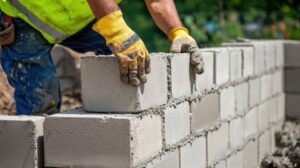McKinney Concrete is a versatile construction material that can be used in a wide range of projects. Its strength and durability make it an ideal choice for paving roads, commercial parking lots, sidewalks, and other large-scale construction.

Concrete is made from a mixture of raw materials, including coarse aggregates such as crushed stone and pea gravel and fine aggregates like sand. These are combined with water and Portland cement in a process called hydration.
Concrete’s strength and durability make it an ideal building material for projects that require heavy loads or withstand compression. The first concrete was created in Ancient Egypt, when builders used a mud and straw mixture to bind dried bricks together. Since then, it has evolved into the form we know and use today. Modern technology continues to improve concrete, allowing for a wider range of applications and stronger structures.
The strength of concrete depends on the type and ratio of the raw materials it contains. In order to get the best results, the cement and aggregate must be correctly proportioned. It is also important to use the right amount of water and concrete admixtures to ensure that the mix is workable when poured and hardens properly.
Concrete is typically reinforced with steel wire mesh or rebar, which increases its tensile and compressive strength and prevents it from cracking due to shrinkage. The addition of these reinforcements also makes the concrete more resistant to corrosion and other environmental factors.
Another type of concrete is pumped concrete, which is mixed on site and then pumped to the area where it will be installed. It is often used to create sidewalks and other pedestrian surfaces, as it can be placed quickly and efficiently. However, pumped concrete isn’t as strong as other forms of concrete.
High-strength concrete is used for structures that need to withstand large amounts of pressure or resist compression, such as bridges and skyscrapers. It is also commonly used in dams and other large infrastructure projects.
In order to increase the strength of concrete, engineers sometimes add fibers or other materials to the mix. These additions can reduce the risk of cracking and help the concrete hold up to more extreme conditions. Some examples of these materials include polypropylene and glass fibers.
A special concrete that is designed to detect damage or weak spots in a structure is called damage-detecting concrete. This type of concrete contains carbon or steel shavings that conduct electricity. When an electrical current passes through the concrete, it causes the particles to light up. This allows engineers to identify areas of concern without having to cut or dig into the structure.
Durability
Concrete is a durable material that is capable of withstanding significant loads and environmental wear. Its strength allows it to withstand freezing and thawing cycles, deicing chemicals, and heavy traffic without deterioration. It can be molded into different shapes and reinforced with steel rebar, fiberglass, or welded wire mesh to improve its durability even further. It also resists earthquakes and typhoons.
One of the main reasons why concrete is so durable is its permeability. Unlike the old-fashioned concrete made from cement, sand, and stone, modern high-strength concrete uses chemical admixtures to reduce its permeability and increase its strength. The concrete mix is then placed in precast molds to achieve the required shape and size. The resulting concrete is then cast into bridges, roadways, and buildings. The permeability of concrete can be tested using the BS 1881-122:2011 test. The test measures the amount of water that permeates into a concrete sample. A low absorption indicates good durability.
Another important aspect of durability is its ability to withstand corrosion. Embedded steel rebar can be prone to corrosion, which can damage surrounding concrete and lead to structural failure. To combat this, the concrete is treated with corrosion inhibitors or cathodic protection systems. These protective coatings can help extend the life of the concrete and prevent costly maintenance.
The durability of concrete is influenced by the quality of the materials used, the construction methods, and the environment in which it is built. It is important to consider all of these factors when designing a structure. Insufficient attention to these issues can result in serious and potentially catastrophic failures.
To avoid these disasters, it is essential to use high-quality concrete and to design structures that will withstand the forces of nature. In addition, the use of sustainable practices like incorporating supplementary cementitious materials and reducing water consumption can make concrete more durable and sustainable.
Durability is a key factor in the design of concrete structures, and it can be measured by the time it takes for aggressive agents to penetrate the concrete cover and reach the embedded steel rebar, alter the initial passivation condition on the steel surface, and cause corrosion initiation. The concrete must also be able to withstand the corrosion process until the corrosion rate reaches an unacceptable limit state, which is usually the point at which the reinforcement begins to show signs of deterioration.
Versatility
Concrete is a versatile material that can be used for both structural and decorative purposes. It is a popular building material for construction projects of all sizes and types. It is composed of cement, water, and aggregates such as sand, gravel, or crushed stone. The chemical reaction between the cement and the water creates a hard, durable material that can be molded into different shapes. Concrete is a popular choice for residential buildings, commercial buildings, and infrastructure development projects.
Unlike other construction materials, concrete is highly tolerant of harsh conditions. It can withstand freezing temperatures, frequent rain, and heavy traffic. It is also durable and requires little maintenance, which makes it a cost-effective solution for construction projects. In addition, it is resistant to corrosion and other damage from chemicals.
These qualities have led to a wide variety of applications for concrete over the years. This versatility stems from the characteristics of the material, which are both inherent to it and imparted by decades of development. These characteristics include its malleability and its ability to be shaped on-site. The mix of varying constituents also contributes to this adaptability, with each type of concrete having its own unique properties.
In the 19th and 20th centuries, technological advancements made concrete even more versatile. For instance, the invention of reinforced concrete allowed for taller buildings and longer bridges. The concrete used in these structures was often mixed with steel bars to increase its tensile strength. In addition, the creation of precast concrete enabled these structures to be built on a much larger scale.
Today, concrete continues to be a staple in modern construction. It is used in the foundations, walls, floors, and roofs of many homes. In addition, it is often used in public infrastructure, such as roads and sidewalks. In addition, concrete is also environmentally friendly and can withstand natural forces such as earthquakes and soil movement.
In the future, concrete will likely continue to evolve. One such development is smart concrete, which contains shape memory polymers that fill cracks and imperfections automatically. Another is self-heating concrete, which uses solar energy to heat itself. These developments will improve the performance of concrete in harsh climates and reduce energy costs for homeowners.
Sustainability
Concrete is a construction material that has long been the building industry’s most sustainable choice. It is used in a wide range of construction projects, from buildings and highways to sidewalks and patios. Unlike other materials, such as wood, concrete requires no additional treatment or finishing that could contribute to the release of volatile organic compounds (VOCs) into the air.
Because it is produced on site, using local materials, and often with minimal energy and water consumption, concrete also has low embodied impact. Additionally, it is easy to recycle and reuse, which further decreases its environmental footprint.
Moreover, concrete mix designs frequently include industrial byproducts and waste materials that would otherwise be landfilled (such as fly ash, ground granulated blast furnace slag, silica fume, and other supplemental cementitious materials). This practice reduces the amount of primary raw materials required in the production process, further decreasing its footprint. Concrete can also be cast close to the construction site, minimizing transportation.
Furthermore, a recently developed method for carbon dioxide (CO2) sequestration in concrete may offer new sustainability benefits. This research, conducted by MIT researchers Damian Stefaniuk, Franz-Josef Ulm, and Admir Masic, shows that adding captured CO2 to the concrete production process can offset some of the emissions associated with its initial production.
Because of its thermal mass, concrete can help keep indoor temperatures stable and conserve energy in cooling seasons. It is a very durable material that can withstand harsh weather conditions, such as extreme heat, freezing temperatures, and rain, while still maintaining its structural integrity.
Lastly, the insulating properties of concrete can help to reduce energy costs by reducing air leakage, which in turn lowers heating and cooling bills.
As the biggest consumers of concrete and cement, governments can accelerate their decarbonization through green public procurement policies. These policies encourage the use of low-carbon cement in public projects, creating demand for more sustainable production technologies and techniques. Philanthropy has played a vital role in these efforts, promoting the importance of Buy Clean policies and supporting experts who can inform decision-making institutions about innovative solutions for concrete and cement.
